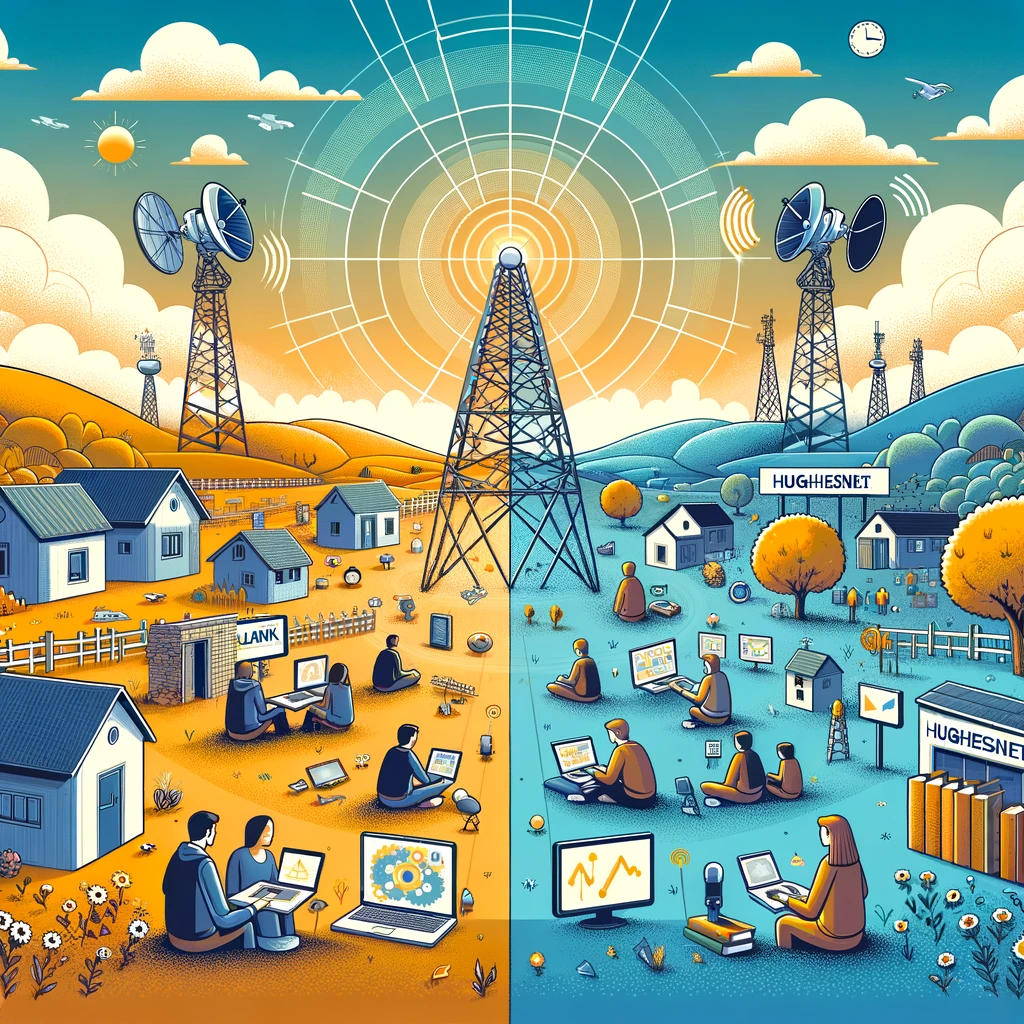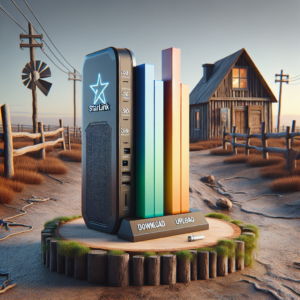
Key Takeaways
Starlink generally offers higher download speeds, ranging from 100Mbps to 220Mbps, which is crucial for video streaming and interactive e-learning.
HughesNet provides consistent speeds up to 100Mbps, with a focus on reliability across its coverage areas.
Latency is lower with Starlink, making it more suitable for real-time online activities, such as video conferencing.
Both services have data limitations, but they differ in terms of caps and policies, affecting extended online learning sessions.
Understanding your specific e-learning needs will help you choose the right service between Starlink and HughesNet.
When it comes to e-learning, especially in rural areas, having a fast and reliable internet connection isn’t just a convenience—it’s a necessity. As we dive into the world of satellite internet, specifically comparing Starlink and HughesNet, we’ll uncover which service might best serve the needs of rural scholars. Let’s get started with some key insights that will guide our exploration.
| Feature | Starlink | HughesNet |
|---|---|---|
| Download Speed | 100Mbps to 220Mbps | Up to 100Mbps |
| Upload Speed | Not mentioned in the provided content | Not mentioned in the provided content |
| Latency | Lower, suitable for real-time activities | Not explicitly mentioned |
| Data Limitations | Has data limitations (specifics not provided) | Has data limitations (specifics not provided) |
| Reliability | Not explicitly mentioned | Focus on reliability |
| Coverage | Wide coverage, suitable for rural areas | Consistent speeds across coverage areas |
Rural E-Learning Relies on Connectivity
Imagine trying to attend a virtual classroom or submit an assignment online, only to be hindered by a sluggish or intermittent internet connection. This is a daily challenge for many rural students. The right internet service can make all the difference, enabling access to educational resources and facilitating seamless communication with teachers and peers.
The Role of Internet Speed in Online Education
Internet speed affects every aspect of online learning. High-speed internet means videos don’t buffer, web pages load quickly, and documents upload in a snap. For rural students, where options are limited, it’s essential to understand how different internet services stack up in terms of speed and reliability.
Assessing E-Learning Platforms’ Requirements
Video streaming services like Zoom or YouTube typically need at least 3Mbps for standard quality.
Interactive learning platforms and online assessments may require speeds of at least 10Mbps to function smoothly.
Downloading large files, such as educational videos or software, can be time-consuming without speeds of at least 25Mbps.
With these requirements in mind, let’s explore the offerings of Starlink and HughesNet to see how they measure up.
Remember: The best internet service for you will depend on your specific needs, such as the number of users and devices in your household, the types of e-learning activities you engage in, and your location.
The New Pioneers of Rural Connectivity
In the quest to connect rural areas to the digital world, two names stand out: Starlink and HughesNet. Both are striving to bridge the connectivity gap, but they do so with different technologies and service offerings.
What Is Starlink?
Starlink is the new kid on the block, brought to us by SpaceX. It’s a satellite internet service that aims to provide high-speed internet across the globe, with a particular focus on remote and underserved areas. With its constellation of low-Earth orbit satellites, Starlink promises faster speeds and lower latency compared to traditional satellite internet.
Introducing HughesNet
HughesNet, on the other hand, is a veteran in the satellite internet market. It operates on a network of geostationary satellites that provide coverage across the entire continental United States. HughesNet is known for its consistent performance and has been a go-to option for rural internet users for years.
Now, let’s roll up our sleeves and compare these two services head-to-head, focusing on the factors that matter most for e-learning: speed, reliability, and data policies.
Breaking Down the Speed Test
Understanding Internet Speed Metrics
Before we compare Starlink and HughesNet, let’s clarify what we mean by internet speed. Speed usually refers to how fast data can be downloaded (download speed) or uploaded (upload speed) to the internet. It’s measured in Megabits per second (Mbps). For e-learning, download speed is critical for streaming educational videos and downloading resources, while upload speed is important for sending assignments and participating in video calls.
Measuring Starlink Speeds
Starlink has been making headlines with its impressive download speeds, which can range from 100Mbps to 220Mbps. That’s a game-changer for rural education, where such speeds were previously unheard of. For students, this means that downloading a 5-minute educational video can take mere seconds, ensuring a smooth and uninterrupted learning experience.
Measuring HughesNet Speeds
HughesNet typically offers download speeds up to 25Mbps, although it can go up to 100Mbps. While this may seem modest compared to Starlink, it’s still sufficient for many e-learning tasks. A consistent 25Mbps can handle video streaming and online course work without major interruptions.

Practical Comparison for Rural Scholars
Now, let’s put these speeds into perspective for our rural scholars. Imagine you’re attending a virtual class; with Starlink’s higher speeds, you’re more likely to enjoy a seamless video stream without frustrating pauses. On the other hand, HughesNet’s consistent speeds mean you can rely on your connection to stay stable throughout the lesson, even if it’s not as fast.
Most importantly, both services offer different data policies, which can affect your e-learning experience. Starlink currently has no hard data caps, but during times of network congestion, users may experience slower speeds. HughesNet offers a set amount of full-speed data each month, after which speeds are reduced, though e-learning activities are still possible at these reduced speeds.
Day-to-Day Internet Use Under Starlink
With Starlink, students in rural areas can expect a robust connection that supports multiple devices and simultaneous high-bandwidth tasks. This means you can participate in a live class while your sibling streams an educational video, without worrying about the dreaded buffer symbol.
The HughesNet Experience
HughesNet users will appreciate the service’s reliability. Even though the speeds aren’t as high as Starlink’s, they’re consistent. You’ll have a clear idea of what your internet can handle, and you can plan your e-learning activities around that. For instance, you might schedule downloads for times when the network is less busy to ensure they complete quickly.
Next Steps for Rural Learners
Choosing the right internet service is a big decision for rural learners. Here’s how to navigate that choice:
Assess your household’s internet needs, considering how many people will be using the connection for e-learning.
Think about the types of online educational resources you use most frequently and their speed requirements.
Consider the data policies of each service, especially if you anticipate needing a lot of data for downloading educational content.
Once you’ve evaluated your needs, compare them against the offerings of Starlink and HughesNet. If your e-learning requires high-speed internet for live interactions and large downloads, Starlink might be the better choice. If you’re looking for a reliable connection that’s consistent and has clearly defined data limits, HughesNet could be the way to go.
Therefore, when choosing your service, it’s not just about speed—it’s about finding the right balance of speed, reliability, and data policy for your specific e-learning needs.
How to Choose the Right Service
When deciding between Starlink and HughesNet, consider the following steps:
Make a list of your e-learning activities and prioritize them by their importance and bandwidth requirements.
Research the coverage area and service availability for Starlink and HughesNet in your region.
Read up on customer reviews and experiences, focusing on aspects like customer service, installation process, and overall satisfaction.
Finally, reach out to each provider for detailed information on plans, pricing, and any educational discounts or subsidies that may apply.
By taking these steps, you’ll be able to make an informed decision that supports your educational goals and ensures you stay connected to the world of learning, no matter where you are.
Tips for Optimizing Your Rural Internet Connection
Besides choosing the right provider, there are practical steps you can take to ensure your internet connection is as strong as possible. For instance, positioning your satellite dish or router in an optimal location, free from obstructions, can improve signal strength. Regularly updating your equipment’s firmware can also ensure your connection runs smoothly. Additionally, consider using wired connections for critical e-learning devices to reduce latency and avoid Wi-Fi interference.
Frequently Asked Questions (FAQ)
When it comes to satellite internet for e-learning, you’re bound to have questions. Let’s address some of the most common concerns to help you make the best decision for your rural educational needs.
Can Starlink or HughesNet Support Multiple Users for E-Learning?
Yes, both Starlink and HughesNet can support multiple users, but Starlink’s higher bandwidth offers more flexibility for simultaneous use. This is particularly important in households with multiple students or a need for concurrent internet activities. However, keep in mind that as more devices connect, the overall speed and performance may be impacted, so it’s essential to choose a plan that can accommodate your household’s usage.
Is it Possible to Upgrade Internet Speeds with Starlink or HughesNet?
With Starlink, the service is continuously improving as more satellites are launched, potentially leading to better speeds and connectivity in the future. HughesNet offers different service plans, but the maximum speeds are generally capped due to the nature of geostationary satellite technology. It’s always a good idea to check with the providers for the latest offerings and upgrades that could benefit your e-learning experience.
What Happens to Internet Speeds During Bad Weather?
Weather can affect satellite internet, with heavy rain, snow, or dense cloud cover potentially disrupting the signal. Starlink, with its lower orbit satellites, may be less susceptible to weather interruptions than HughesNet. However, both providers have technologies in place to mitigate weather-related issues, and service interruptions are usually temporary. Planning your e-learning schedule around typical weather patterns can help minimize disruptions.
For example, if you know a storm is approaching, you might download necessary materials ahead of time or reschedule live online classes to avoid potential connectivity issues.
Are There Any Government Subsidies Available for Rural E-Learning Internet?
The FCC’s Lifeline program offers discounts on internet services for eligible low-income subscribers.
The Emergency Broadband Benefit Program provides temporary discounts on broadband services due to the COVID-19 pandemic.
Some states have their own programs and grants aimed at improving internet access for rural communities.
It’s worth researching these options to see if you qualify for any financial assistance that could make satellite internet more affordable for your e-learning needs.
What Are the Installation Requirements for Starlink and HughesNet?
Both Starlink and HughesNet require a clear view of the sky for optimal performance. Starlink’s user terminal, often referred to as “Dishy,” can be self-installed with the provided kit. HughesNet typically requires professional installation to mount and align the satellite dish. In both cases, ensuring a stable and unobstructed setup is key to getting the best possible internet connection for your e-learning activities.
Now that we’ve covered the essentials of satellite internet for rural e-learning, you should feel empowered to make an informed decision. Whether you lean towards the high speeds of Starlink or the consistent reliability of HughesNet, the right choice will keep you connected to the wealth of knowledge and learning opportunities the internet has to offer. Embrace the digital age of education, and let the sky be the limit to your academic achievements.







